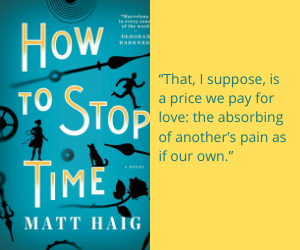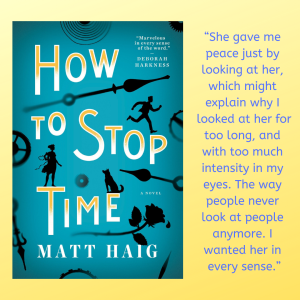
How to Stop Time by Matt Haig
- Publisher: Viking
- Publication Date: February 6, 2018
- Sold by: Penguin Group (USA) LLC
Fantasy, Literary Fiction
Note: This is my first book review on this site. I tend to read like a writer, so my reviews will be filtered for whatever writing lessons I can derive. If you aren’t a writer, just ignore the bullet points at the end.
I started it in December of last year and forced myself to stop in January because of a deadline I’d placed on myself to complete the manuscript on my very first novel. Therefore, I didn’t touch this novel for a good month before returning to it. Unheard of for me and yet somehow appropriate, given the central conceit of the novel.
Tom Hazard is over four hundred years old, though he doesn’t look a day over forty. He suffers from a genetic condition called anageria, which results in significantly slowed aging in its subjects, about one year of aging for every fifteen normal years. More than any other consequence, this condition causes him to be an outsider in time. As normal people age and die like mayflies, Tom is increasingly isolated by his quasi-immortality. This condition is further reinforced by the Albatross Society, a shady group whose goal is to find other albas, or albatrosses, like Tom and protect them from a supposed government conspiracy to perform genetic experiments. However, to remain safely within the Society, members must follow the cardinal rule – never fall in love.

The mood of the novel is that of nostalgia tempered with humor – Tom suffers for his condition and loses much over the centuries because of it. Tom’s story alternates between the past and the present. This structure allows Tom’s backstory to emerge gradually, creating and satisfying the reader’s curiosity. Not all stories manage this shuttling back and forth in time very well but it is essential to this story.
Tom’s isolation is also important to the story, as it places him in the position to make broader observations about the nature of human beings. He comments on the circuitous nature of history, and the way human beings repeat their mistakes over and over, unable to rise above the constraints of their age. To Tom, life is nothing more than a series of moments slipping away, impossible to hold onto because the next moment rushes in, and the next and the next afterwards in unrelenting succession. He’s desperately adrift, having lost touch even with himself, living in quiet despair and profound loneliness. The only reason he doesn’t end his life is because he is searching for his daughter, Marion, who has also inherited his condition.

Haig’s writing is engrossing, describing a man who has lived too long, seen too much and is disconnected from all of it. Tom is fond of music – he plays over thirty instruments by the time we encounter him in the narrative. The author chooses this talent wisely – music is an impermanent pleasure, demanding full immersion from the listener. Like time, music belongs to the moment, slipping away into the past as soon as it is experienced. There is no way to hold it.
The narrative is also full of references to literature and culture, and the reader is treated to meetings with historical figures such as William Shakespeare and F. Scott Fitzgerald which are not as lingering – or interesting – as the reader would hope. At one point in the narrative, Bertrand Russell’s A History of Western Philosophy is referred to as a “m*therfucker” and, as one who took on the task of reading it, I couldn’t help but chuckle in agreement.
However, the reader learns there is a way to stop time, as the title proposes. You can’t escape the hungry maw of time, as it crawls ever forward. But there is the power of memory to recapture lost moments, and the inevitable vulnerability of surrendering to love, which can make time seem irrelevant. The lesson is the same whether one is a mayfly or an albatross.

It’s easy to get lost in this novel, which is the number one requirement for a good read. The writing is controlled and precise. The plot was credible, though the writer does expect a certain suspension of disbelief towards the end, as if he’d out-plotted himself and needed some way to undo the knot. No matter; it doesn’t detract from the overall pleasure of the book.
Note to writers:
- Excellent example of threading back story through the narrative
- Shifts in time clearly marked with chapter changes
- First person narration that is not claustrophobic because focus is on both the internal life of character and the descriptions of the external environment (balance between navel gazing and physical setting)
- Writing can be aphoristic but just skirts the realm of the “fortune cookie.”
I should rate these, shouldn’t I? I think it’s a solid 4.5 out of 5 stars.




![]()
  
 


  
 

